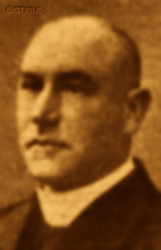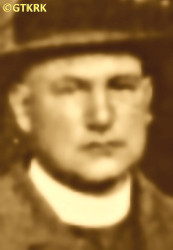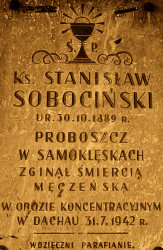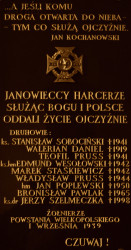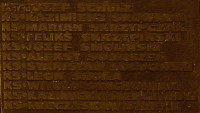Roman Catholic
St Sigismund parish
05-507 Słomczyn
85 Wiślana Str.
Konstancin deanery
Warsaw archdiocese, Poland
full list:
displayClick to display full list

searchClick to search full list by categories
wyświetlKliknij by wyświetlić pełną listę po polsku

szukajKliknij by przeszukać listę wg kategorii po polsku

Martyrology of the clergy — Poland
XX century (1914 – 1989)
personal data
surname
SOBOCIŃSKI
forename(s)
Stanislav (pl. Stanisław)
function
diocesan priest
creed
Latin (Roman Catholic) Church RCmore on
en.wikipedia.org
[access: 2014.09.21]
diocese / province
Gniezno and Poznań archdiocese (aeque principaliter)more on
www.archpoznan.pl
[access: 2012.11.23]
RC Military Ordinariate of Polandmore on
en.wikipedia.org
[access: 2014.12.20]
honorary titles
„Medal of Independence”more on
en.wikipedia.org
[access: 2019.02.02]
(20.12.1932)
„Cross of Valour”more on
en.wikipedia.org
[access: 2019.04.16]
Gold „Cross of Merit”more on
en.wikipedia.org
[access: 2019.04.16]
(11.11.1937)
date and place
of death
31.07.1942

KL Dachauconcentration camp
today: Dachau, Upper Bavaria reg., Bavaria state, Germany
more on
en.wikipedia.org
[access: 2016.05.30]
details of death
At the beginning of 1920, joined the Polish Army. Became the chaplain of the 60th Greater Poland Infantry Regiment, which had its origins in the Leszno Group, formed during the Greater Poland Uprising of 1919‐1921, and later transformed into the 6th Greater Poland Rifle Regiment. That unit — already as the 60th Regiment — was stationed in Bydgoszcz, which it occupied on 20.01.1920, during the incorporation of Pomerania into Poland.
On 08.03.1920 the Regiment was transferred to the Horyn River line in Volyn, near the railway line connecting Rivne with Ukraine and Kiev — to the southern front of the Polish–Russian War of 1919‐1921. There, on 25.04.1920, along the aforementioned line, it set off eastwards — the so‐called Kiev expedition was starting. Reached Vasylkiv, east of Kiev, and from there took part in the Battle of Kiev 08‐11.05.1920. During the battle, crossed the Dnieper River and took up protective positions east of the city, near the town of Brovary. These events were described in the application for the order as follows: „Near Kiev on 11.05.1920, when […] the right wing of the Regiment was completely cut off, reached it through the marshes, carrying a message that the Regiment commander was receiving reinforcements and would soon establish contact with the regiment line, and taking seventeen seriously wounded men and a killed officer on expropriated carts with him, led them away by a secret route to the regimental dressing station, disregarding the clearly threatening danger of an attack by Bolshevik cavalry, which had the forest through which had to travel in its hands”.
Next the Regiment was transported to the Northern Front, Lithuanian–Belarusian, where in 05.1920 the Russians attacked the Polish defensive lines along the Berezina River — to Khotaevichy, c. 60 km north of Minsk. From there on 01.06.1920 the Polish counter–offensive began. In continuous marches and fighting the Regiment reached, passing through Dokshytsy, the upper Berezina, and stopped near the Chernichka farm, on Lake Medzasol. There, on 09‐19.06.1920, „where the Regiment repelled over 40 Bolshevik attacks in ten days, constantly reached the line, dressed and collected the wounded, administered the holy sacraments in the position and tried to have them transported to the regimental dressing station and the medical frontmen” (Ibid.).
Was also there when the great Russian offensive began on 04.07.1920 under the command of General Mikhail Tukhachevsky. Polish troops were forced to retreat to the west. In constant defensive clashes, on 13.07.1920 the Regiment reached Ivyanets, on the eastern shore of the Naliboki Forest, where „in a hail of bullets, lying next to the seriously wounded, administered the holy sacraments and crawled from one to another wounded man to give the holy sacraments” (Ibid.). Then, on 20.07.1920, it reached the line of the Shchara River, from where withdrew more or less along the Vawkavysk–Warsaw railway line. Among others, on 31.07.1920, near Drochiczyn on the Bug River, during the so‐called Battle of Brańsk, „during the retreat [...], being seriously ill with diarrhea, was the only one to provide sanitary and Christian help in the general chaos of various regiments, despite the confusion and three‐day bad weather”.
The Regiment reached the vicinity of the Vistula River and took up positions near Okuniew, defending the access to Warsaw. When the decisive Battle of Warsaw (known as the „Miracle on the Vistula”) began on c. 15.08.
1920, the main Russian attack on Warsaw bypassed it, but after the beginning of the Polish counterattack from the Wieprz River ‐ along south to north line, cutting the supply lines of the Russian army — joined it on 17.08.1920 at Dębe Wielkie, and then from 18.08.1920 chasing the Russians through Stanisławów, Łomża reached Kolno, which it captured on 23.08.1920, and then drove the Russians away and forced them to cross the border with Germany — to East Prussia.
The battle was won, but not the war. On 14.09.1920 the Regiment was transferred to the north of the Białowieża Forest, and then on 22.09.1920 it moved to Shurichi, to take part in the already ongoing great Battle of the Neman on 20–26.09.1920, capturing, among others, Vawkavysk. After the Polish triumph, the pursuit of the fleeing Russians began, marked by many skirmishes, including the battle for the town of Mir on 03.10.1920, ending about 40 km before Minsk. There, the Regiment received news of the armistice concluded on 12.01.1920.
Till 12.12.1920 the Regiment defended the Polish–Russian demarcation line, after which it returned to Wielkopolska, to Ostrów Wielkopolski.
On 16.12.1921, released from active service in the Polish Army and transferred to the reserve. Also in 1923, 1924, 1925, 1927 and 1929, appointed reserve chaplain of the Polish Army (from 25.11.1926 each time for a statutory period of 2 years).
After German and Russian invasion of Poland in 09.1939 and start of the World War II, after start of German occupation, arrested by the Germans on 13.11.1939.
Jailed in ZL Schubin transit camp and from 15.11.1939 in Górna Grupa transit camp.
On 05.02.1940 transported to ZL Neufahrwasser in Gdańsk transit camp and from there on 08.02.1940 to KL Stutthof concentration camp.
Next on 09‐10.04.1940 moved to KL Sachsenhausen concentration camp.
Finally on 14.12.1940 brought to KL Dachau concentration camp where perished.
According to the death certificate, prepared in KL Dachau, the „honest” otherwise German „medical doctors” and formalists — and at the same time, unrivaled fairy tale spinners — noted that the cause of death was Germ. „Versagen von Herz und Kreislauf, bei offener Lungentuberkulose” (Eng. „Heart and circulatory failure, due to open pulmonary tuberculosis”).
prisoner camp's numbers
22694Click to display source page (KL DachauClick to display the description)
cause of death
extermination: exhaustion and starvation
perpetrators
Germans
sites and events
KL DachauClick to display the description, KL SachsenhausenClick to display the description, KL StutthofClick to display the description, ZL NeufahrwasserClick to display the description, DL Ober GruppeClick to display the description, ZL SchubinClick to display the description, «Intelligenzaktion»Click to display the description, Reichsgau Danzig‐WestpreußenClick to display the description, Ribbentrop‐MolotovClick to display the description, Pius XI's encyclicalsClick to display the description
date and place
of birth
30.10.1889Birth certification on:
www.genealogiawarchiwach.pl
[access: 2025.09.08]

Murzynnotoday: Gniewkowo gm., Inowrocław pov., Kuyavia‐Pomerania voiv., Poland
more on
en.wikipedia.org
[access: 2021.12.18]
parents
SOBOCIŃSKI Joseph
🞲 ?, ? — 🕆 ?, ?

BENEDYKCIŃSKA Elisabeth
🞲 ?, ? — 🕆 ?, ?
presbyter (holy orders)
ordination
01.03.1914

Poznańtoday: Poznań city pov., Greater Poland voiv., Poland
more on
en.wikipedia.org
[access: 2021.07.18]
St Peter and St Paul the Apostles RC archcathedral churchmore on
en.wikipedia.org
[access: 2025.03.14]
positions held
1923 – 1939
parish priest — Samoklęski Dużetoday: Szubin gm., Nakło nad Notecią pov., Kuyavia‐Pomerania voiv., Poland
more on
en.wikipedia.org
[access: 2021.07.18] ⋄ St Bartholomew the Apostle RC parish ⋄ Kcyniatoday: Kcynia gm., Nakło nad Notecią pov., Kuyavia‐Pomerania voiv., Poland
more on
en.wikipedia.org
[access: 2021.07.18] RC deanery
1923
administrator — Pieranietoday: Dąbrowa Biskupia gm., Inowrocław pov., Kuyavia‐Pomerania voiv., Poland
more on
en.wikipedia.org
[access: 2021.07.18] ⋄ St Nicholas the Bishop and Confessor RC parish ⋄ Gniewkowotoday: Gniewkowo gm., Inowrocław pov., Kuyavia‐Pomerania voiv., Poland
more on
en.wikipedia.org
[access: 2020.11.27] RC deanery — acting („ad interim”)
1922 – c. 1923
administrator — Brudniatoday: Dąbrowa Biskupia gm., Inowrocław pov., Kuyavia‐Pomerania voiv., Poland
more on
en.wikipedia.org
[access: 2021.07.18] ⋄ St Michael the Archangel RC parish ⋄ Gniewkowotoday: Gniewkowo gm., Inowrocław pov., Kuyavia‐Pomerania voiv., Poland
more on
en.wikipedia.org
[access: 2020.11.27] RC deanery
1921
RC military chaplain — Gnieznotoday: Gniezno urban gm., Gniezno pov., Greater Poland voiv., Poland
more on
en.wikipedia.org
[access: 2021.12.18] ⋄ garrison, Corps District OK No. VII Poznań, Polish Armed Forces — prob.; by L. 3449 decree of the Commander‐in‐Chief of 16.12.1921, verified with seniority from 01.04.1920 and 8th place on the list of Roman Catholic military chaplains, in the rank of captain, with simultaneous transfer to the reserve of the Polish Army
1920
RC military chaplain — 60th Greater Poland Infantry Regiment, Polish Armed Forces
1918 – c. 1920
vicar — Gnieznotoday: Gniezno urban gm., Gniezno pov., Greater Poland voiv., Poland
more on
en.wikipedia.org
[access: 2021.12.18] ⋄ St Lawrence the Martyr RC parish ⋄ Gniezno Holy Trinitydeanery name
today: Gniezno urban gm., Gniezno pov., Greater Poland voiv., Poland
more on
en.wikipedia.org
[access: 2021.12.18] RC deanery
1915 – c. 1918
vicar — Janowiectoday: Janowiec Wielkopolski, Janowiec Wielkopolski gm., Żnin pov., Kuyavia‐Pomerania voiv., Poland
more on
en.wikipedia.org
[access: 2021.07.18] ⋄ St Nicholas the Bishop and Confessor RC parish ⋄ Gniezno St Peter and St Pauldeanery name
today: Gniezno urban gm., Gniezno pov., Greater Poland voiv., Poland
more on
en.wikipedia.org
[access: 2021.12.18] RC deanery — founder, organizer, activist and chaplain of the scouts in his parish
c. 1916
administrator — Kołdrąbtoday: Janowiec Wielkopolski gm., Żnin pov., Kuyavia‐Pomerania voiv., Poland
more on
en.wikipedia.org
[access: 2021.07.18] ⋄ St John the Baptist RC parish ⋄ Gniezno St Peter and St Pauldeanery name
today: Gniezno urban gm., Gniezno pov., Greater Poland voiv., Poland
more on
en.wikipedia.org
[access: 2021.12.18] RC deanery — acting („ad interim”)
1914 – 1916
vicar — Łopiennotoday: Mieleszyn gm., Gniezno pov., Greater Poland voiv., Poland
more on
en.wikipedia.org
[access: 2021.12.18] ⋄ Blessed Virgin Mary of the Assumption RC parish ⋄ Gniezno St Peter and St Pauldeanery name
today: Gniezno urban gm., Gniezno pov., Greater Poland voiv., Poland
more on
en.wikipedia.org
[access: 2021.12.18] RC deanery
till 1914
student — Gnieznotoday: Gniezno urban gm., Gniezno pov., Greater Poland voiv., Poland
more on
en.wikipedia.org
[access: 2021.12.18] ⋄ philosophy and theology, Archbishop's Practical Theological Seminary (Lat. Seminarium Clericorum Practicum)
student — Poznańtoday: Poznań city pov., Greater Poland voiv., Poland
more on
en.wikipedia.org
[access: 2021.07.18] ⋄ philosophy and theology, Archbishop's Theological Seminary (Collegium Leoninum)
sites and events
descriptions
KL Dachau: KL Dachau in German Bavaria, set up in 1933, became the main German Germ. Konzentrationslager (Eng. concentration camp) KL for Catholic priests and religious during World War II: On c. 09.11.1940, Reichsführer‐SS Heinrich Himmler, head of the SS, Gestapo and German police, as a result of the Vatican's intervention, decided to transfer all clergymen detained in various concentration camps to KL Dachau camp. The first major transports took place on 08.12.1940. In KL Dachau Germans held approx. 3,000 priests, including 1,800 Poles. The priests were forced to slave labor in the Germ. „Die Plantage” — the largest herb garden in Europe, managed by the genocidal SS, consisting of many greenhouses, laboratory buildings and arable land, where experiments with new natural medicines were conducted — for many hours, without breaks, without protective clothing, no food. They slaved in construction, e.g. of camp's crematorium. In the barracks ruled hunger, freezing cold in the winter and suffocating heat during the summer, especially acute in 1941‐1942. Prisoners suffered from bouts of illnesses, including tuberculosis. Many were victims of murderous „medical experiments” — in 11.1942 c. 20 were given phlegmon injections; in 07.1942 to 05.1944 c. 120 were used by for malaria experiments. More than 750 Polish clerics where murdered by the Germans, some brought to TA Hartheim euthanasia centre set up in Schloss Hartheim in Austria and murdered in gas chambers. At its peak KL Dachau concentration camps’ system had nearly 100 slave labour sub‐camps located throughout southern Germany and Austria. There were c. 32,000 documented deaths at the camp, and thousands perished without a trace. C. 10,000 of the 30,000 inmates were found sick at the time of liberation, on 29.04.1945, by the USA troops… (more on: www.kz-gedenkstaette-dachau.deClick to attempt to display webpage
[access: 2013.08.10], en.wikipedia.orgClick to attempt to display webpage
[access: 2016.05.30])
KL Sachsenhausen: In Germ. Konzentrationslager (Eng. concentration camp) KL Sachsenhausen, set up in the former Olympic village in 07.1936, hundreds of Polish priests were held in 1940, before being transported to KL Dachau. Some of them perished in KL Sachsenhausen. Murderous medical experiments on prisoners were carried out in the camp. In 1942‐1944 c. 140 prisoners slaved at manufacturing false British pounds, passports, visas, stamps and other documents. Other prisoners also had to do slave work, for Heinkel aircraft manufacturer, AEG and Siemens among others. On average c. 50,000 prisoners were held at any time. Altogether more than 200,000 inmates were in jailed in KL Sachsenhausen and its branched, out of which tens of thousands perished. Prior to Russian arrival mass evacuation was ordered by the Germans and c. 80,000 prisoners were marched west in so‐called „death marches” to other camps, i.e. KL Mauthausen‐Gusen and KL Bergen‐Belsen. The camp got liberated on 22.04.1945. After end of armed hostilities Germans set up there secret camp for German prisoners and „suspicious” Russian soldiers. (more on: en.wikipedia.orgClick to attempt to display webpage
[access: 2018.11.18])
KL Stutthof: In German Germ. Konzentrationslager (Eng. concentration camp) KL Stutthof (then in Eastern Prussian belonging to Germany, today: Sztutowo village) concentration camp, that Germans started to build on 02.09.1939, a day after German invasion of Poland and start of the World War II, Germans held c. 110,000‐127,000 prisoners from 28 countries, including 49,000 women and children. C. 65,000 victims were murdered and exterminated. In the period of 25.01‐27.04.1945 in the face of approaching Russian army Germans evacuated the camp. When on 09.05.1945 Russians soldiers entered the camp only 100 prisoners were still there. In an initial period (1939‐1940) Polish Catholic priests from Pomerania were held captive there before being transported to KL Dachau concentration camp. Some of them were murdered in KL Stutthof or vicinity (for instance in Stegna forest). Also later some Catholic priests were held in KL Stutthof. (more on: stutthof.orgClick to attempt to display webpage
[access: 2018.11.18], en.wikipedia.orgClick to attempt to display webpage
[access: 2013.07.06])
ZL Neufahrwasser: Germ. Zivilgefangenenlager (Eng. POW camp for civilians) organized by the Germans on the day of the outbreak of the war, on 01.09. 1939, in Gdańsk ‐ Nowy Port (New Port), in former artillery barracks belonging to Poland, for Poles from Pomerania arrested as part of the «Intelligenzaktion» action — extermination of Polish intelligentsia. Prisoners from ZL Neufahrwasser — 2,702 people were identified, but it is estimated that c. 10,000 arrestees passed through the camp — were sent to the KL Stutthof concentration camp or directly to the places of extermination. The camp operated till 01.04.1940 (more on: stutthof.orgClick to attempt to display webpage
[access: 2013.08.10], ofiaromwojny.republika.plClick to attempt to display webpage
[access: 2013.12.04])
DL Ober Gruppe: From 10.1939 till c. 04.1940, in the Divine Word Missionaries SVD Congregation's house in Górna Grupa — taken over by the Germans after the suspension of the activities of the Minor Seminary run by the friars, and their internment, and the repurposing of the building for military purposes — the Germans organized a Germ. Durchgangslager (Eng. Transit camp), i.e. DL Ober Gruppe, for Poles, including 95 Polish clergy, from the Świecie, Bydgoszcz, Chełmno, Grudziądz, and Starogard Gdański regions in Pomerania. C. 50 of them — detained as part of the Germ. «Intelligenzaktion» (Eng. „Action Intelligence”), i.e. the extermination of the Polish intelligentsia and leadership classes in Pomerania — perished, a significant number of them murdered at the execution sites in Mniszek‐Grupa. In the same place in 1945 Russians set up a concentration camp for Germans, among whom two priests perished. (more on: pl.wikipedia.orgClick to attempt to display webpage
[access: 2021.12.19], www.kpbc.ukw.edu.plClick to attempt to display webpage
[access: 2013.12.27])
ZL Schubin: From 26.09.1939 to the beginning of 1940 in Szubin — where the occupation began on 05.09.1939, when the Germans entered the city — Germ. Zivilinternierungslager (Eng. transit camp for civilians) was organised. On the premises of the pre‐war Educational Institue, interned Polish POWs and civilians (e.g. teachers and Greater Poland uprising veterans) were detained by the Germans prior to being deported from Pomerania or sent to concentration camps. In later years, the Germans organized there Stalag XXI B2 Schubin (03‐05.1940), and then Oflag XXI B, a camp for allied officers, mainly French and British. In 1943 the name was changed to Oflag 64 Altburgund (after escape of 43 POWs), and the camp was designated almost exclusively to American officers. There were c. 20,000 prisoners in total in the camp (c. 5,000 at one time). Empty camp — earlier the Germans forced the remaining prisoners to march west — the Russians captured on 23.01.1945.
«Intelligenzaktion»: German: «Intelligenzaktion» (English: „Intelligence Action”) — a German program of extermination of the Polish elite, mainly the intelligentsia and leadership layers, carried out from the beginning of the occupation in w 09.1939 to 04.1940, mainly in territories directly annexed to Germany, but also in the so‐called Germ. Generalgouvernement (Eng. General Governorate), where it was called «AB‐aktion». In the first phase, immediately after the beginning of the German occupation, during military operations carried out by the Germ. Wehrmacht (Eng. Armed Forces) and the genocidal units of the Germ. Einsatzgruppen (Eng. Operational Groups) of the Germ. Sicherheitspolizei (Eng. Security Police), i.e. SiPo, and Germ. Sicherheitsdienst des Reichsführers SS (Eng. Security Service of the Reichsführer SS), i.e. SD, organized by the Germ. Reichssicherheitshauptamt (Eng. Reich Main Security Office), i.e. RSHA, which followed the troops, carried out under the Germ. Unternehmen „Tannenberg” (Eng. Operation „Tannenberg”) — based on the so‐called Germ. Sonderfahndungsliste (Eng. Special Wanted Lists), i.e. proscription lists of Poles considered particularly dangerous to the Third Reich, prepared by the Zentralstelle II/P (Polen) unit of the German RSHA. Later, implemented by the German civilian occupation authorities and the genocidal unit of the Germ. Volksdeutscher Selbstschutz (Eng. Ethnic Germans Self‐Defense), whose members were Germ. Volksdeutsche (Eng. Ethnic Germans), i.e. representatives of the German minority in Poland. According to various sources, these lists, at the beginning of 09.1939, could have contained the details of 61,000—88,000 „dangerous” Poles — although these figures cannot be confirmed. In total, during this genocide, c. 50,000 teachers, Catholic priests, representatives of the landed gentry, freelancers, social and political activists, and retired military personnel were systematically and methodically murdered. Another 50,000 were sent to concentration camps, where only a negligible percentage survived. (more on: en.wikipedia.orgClick to attempt to display webpage
[access: 2014.10.04])
Reichsgau Danzig‐Westpreußen: After the Polish defeat in the 09.1939 campaign, which was the result of the Ribbentrop‐Molotov Pact and constituted the first stage of World War II, and the beginning of German occupation in part of Poland (in the other, eastern part of Poland, the Russian occupation began), the Germans divided the occupied Polish territory into five main regions (and a few smaller). The largest one was transformed into Germ. Generalgouvernement (Eng. General Governorate), intended exclusively for Poles and Jews and constituting part of the so‐called Germ. Großdeutschland (Eng. Greater Germany). Two were added to existing German provinces. From two other separate new provinces were created. Vistula Pomerania region was one of them, incorporated into Germany on 08.10.1939, by decree of the German leader Adolf Hitler (formally came into force on 26.10.1939), and on 02.11.1939 transformed into the Germ. Reichsgau Danzig‐Westpreußen (Eng. Reich District of Gdańsk‐West Prussia) province, in which the law of the German state was to apply. The main axis of the policy of the new province, the territory of which the Germans recognized as the Germ. „Ursprünglich Deutsche” (Eng. „natively German”), despite the fact that 85% of its inhabitants were Poles, was Germ. „Entpolonisierung” (Eng. „Depolonisation”), i.e. forced Germanization. C. 60,000 Poles were murdered in 1939‐1940, as part of the Germ. „Intelligenzaktion”, i.e. extermination of Polish intelligentsia and ruling classes, in c. 432 places of mass executions — including c. 220 Polish Catholic priests. The same number were sent to German concentration camps, from where few returned (over 300 priests were arrested, of whom c. 130 died in concentration camps). C. 124,000‐170,000 were displaced, including c. 90,000 to the Germ. Generalgouvernement. Poles were forced en masse to sign the German nationality list, the Germ. Deutsche Volksliste DVL. Polish children could only learn in German. It was forbidden to use the Polish language during Catholic Holy Masses and during confession. Polish landed estates were confiscated..To further reduce the number of the Polish population, Poles were sent to forced labor deep inside Germany. The remaining Poles were treated as low‐skilled labor, isolated from the Germans and strictly controlled — legally, three or three of them could only meet together, even in their own apartments. Many were conscripted into the German Wehrmacht army. After the end of hostilities of World War II, the overseer of this province, the Germ. Reichsstatthalter (Eng. Reich Governor) and the Germ. Gauleiter (Eng. district head) of the German National Socialist Party, Albert Maria Forster, was executed. (more on: en.wikipedia.orgClick to attempt to display webpage
[access: 2024.06.24])
Ribbentrop‐Molotov: Genocidal Russian‐German alliance pact between Russian leader Joseph Stalin and German leader Adolf Hitler signed on 23.08.1939 in Moscow by respective foreign ministers, Mr. Vyacheslav Molotov for Russia and Joachim von Ribbentrop for Germany. The pact sanctioned and was the direct cause of joint Russian and German invasion of Poland and the outbreak of the World War II in 09.1939. In a political sense, the pact was an attempt to restore the status quo ante before 1914, with one exception, namely the „commercial” exchange of the so‐called „Kingdom of Poland”, which in 1914 was part of the Russian Empire, fore Eastern Galicia (today's western Ukraine), in 1914 belonging to the Austro‐Hungarian Empire. Galicia, including Lviv, was to be taken over by the Russians, the „Kingdom of Poland” — under the name of the General Governorate — Germany. The resultant „war was one of the greatest calamities and dramas of humanity in history, for two atheistic and anti‐Christian ideologies — national and international socialism — rejected God and His fifth Decalogue commandment: Thou shall not kill!” (Abp Stanislav Gądecki, 01.09.2019). The decisions taken — backed up by the betrayal of the formal allies of Poland, France and Germany, which on 12.09.1939, at a joint conference in Abbeville, decided not to provide aid to attacked Poland and not to take military action against Germany (a clear breach of treaty obligations with Poland) — were on 28.09.1939 slightly altered and made more precise when a treaty on „German‐Russian boundaries and friendship” was agreed by the same murderous signatories. One of its findings was establishment of spheres of influence in Central and Eastern Europe and in consequence IV partition of Poland. In one of its secret annexes agreed, that: „the Signatories will not tolerate on its respective territories any Polish propaganda that affects the territory of the other Side. On their respective territories they will suppress all such propaganda and inform each other of the measures taken to accomplish it”. The agreements resulted in a series of meeting between two genocidal organization representing both sides — German Gestapo and Russian NKVD when coordination of efforts to exterminate Polish intelligentsia and Polish leading classes (in Germany called «Intelligenzaktion», in Russia took the form of Katyń massacres) where discussed. Resulted in deaths of hundreds of thousands of Polish intelligentsia, including thousands of priests presented here, and tens of millions of ordinary people,. The results of this Russian‐German pact lasted till 1989 and are still in evidence even today. (more on: en.wikipedia.orgClick to attempt to display webpage
[access: 2015.09.30])
Pius XI's encyclicals: Facing the creation of two totalitarian systems in Europe, which seemed to compete with each other, though there were more similarities than contradictions between them, Pope Pius XI issued in 03.1937 (within 5 days) two encyclicals. In the „Mit brennender Sorge” (Eng. „With Burning Concern”) published on 14.03.1938, condemned the national socialism prevailing in Germany. The Pope wrote: „Whoever, following the old Germanic‐pre‐Christian beliefs, puts various impersonal fate in the place of a personal God, denies the wisdom of God and Providence […], whoever exalts earthly values: race or nation, or state, or state system, representatives of state power or other fundamental values of human society, […] and makes them the highest standard of all values, including religious ones, and idolizes them, this one […] is far from true faith in God and from a worldview corresponding to such faith”. On 19.03.1937, published „Divini Redemptoris” (Eng. „Divine Redeemer”), in which criticized Russian communism, dialectical materialism and the class struggle theory. The Pope wrote: „Communism deprives man of freedom, and therefore the spiritual basis of all life norms. It deprives the human person of all his dignity and any moral support with which he could resist the onslaught of blind passions […] This is the new gospel that Bolshevik and godless communism preaches as a message of salvation and redemption of humanity”… Pius XI demanded that the established human law be subjected to the natural law of God , recommended the implementation of the ideal of a Christian state and society, and called on Catholics to resist. Two years later, National Socialist Germany and Communist Russia came together and started World War II. (more on: www.vatican.vaClick to attempt to display webpage
[access: 2023.05.28], www.vatican.vaClick to attempt to display webpage
[access: 2023.05.28])
sources
personal:
www.muzeum.szubin.netClick to attempt to display webpage
[access: 2013.12.27], www.archiwum.archidiecezja.plClick to attempt to display webpage
[access: 2013.08.10], www.genealogiawarchiwach.plClick to attempt to display webpage
[access: 2025.09.08], www.ipgs.usClick to attempt to display webpage
[access: 2012.11.23], ordynariat.wp.mil.plClick to attempt to display webpage
[access: 2024.12.13]
bibliographical:
„International Tracing Service (ITS), Bad Arolsen, GermanyClick to display source page”, Arolsen Archives
original images:
www.wtg-gniazdo.orgClick to attempt to display webpage
[access: 2012.11.23], muzeum.szubin.netClick to attempt to display webpage
[access: 2019.10.13], www.muzeum.szubin.netClick to attempt to display webpage
[access: 2013.12.27], www.muzeum.szubin.netClick to attempt to display webpage
[access: 2013.12.27], www.wtg-gniazdo.orgClick to attempt to display webpage
[access: 2012.11.23]
LETTER to CUSTODIAN/ADMINISTRATOR
If you have an Email client on your communicator/computer — such as Mozilla Thunderbird, Windows Mail or Microsoft Outlook, described at WikipediaPatrz:
en.wikipedia.org, among others — try the link below, please:
LETTER to CUSTODIAN/ADMINISTRATORClick and try to call your own Email client
If however you do not run such a client or the above link is not active please send an email to the Custodian/Administrator using your account — in your customary email/correspondence engine — at the following address:

giving the following as the subject:
MARTYROLOGY: SOBOCIŃSKI Stanislav
To return to the biography press below:
 Click to return to biography
Click to return to biography








